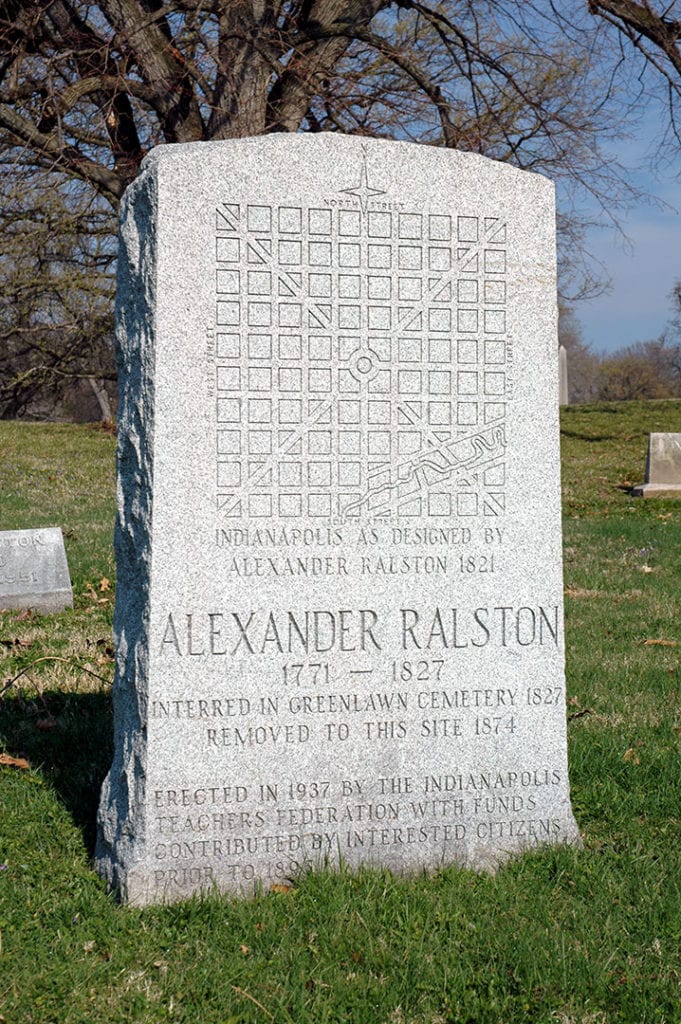Shaping Downtown
 Born in Scotland around 1771, Ralston immigrated to the United States shortly after the American Revolution. He received training as an engineer, and in 1791 he served as a personal assistant to Pierre L’Enfant while he was making plans for the design of Washington, D.C. After L’Enfant was relieved of his duties in 1792, Ralston continued working on the engineering and surveying staff of the nation’s capitol until 1797. Around 1800, he moved to the Ohio River Valley, settling in Louisville, Kentucky. According to some sources, he was hired by Aaron Burr to do surveying in the western territories. Burr had himself moved west after completing his term as vice president in 1805, and when Burr was accused of some shady and possibly treasonous activities, Ralston, though not directly involved, thought it best to lay low and then moved to Salem, Indiana, around 1814.
Born in Scotland around 1771, Ralston immigrated to the United States shortly after the American Revolution. He received training as an engineer, and in 1791 he served as a personal assistant to Pierre L’Enfant while he was making plans for the design of Washington, D.C. After L’Enfant was relieved of his duties in 1792, Ralston continued working on the engineering and surveying staff of the nation’s capitol until 1797. Around 1800, he moved to the Ohio River Valley, settling in Louisville, Kentucky. According to some sources, he was hired by Aaron Burr to do surveying in the western territories. Burr had himself moved west after completing his term as vice president in 1805, and when Burr was accused of some shady and possibly treasonous activities, Ralston, though not directly involved, thought it best to lay low and then moved to Salem, Indiana, around 1814.
When Indiana became a state in 1816, the capitol city was Corydon, a city near the Ohio River. Around 1820, the state’s leaders decided to build a new capitol city near the geographic center of the state. Judge Christopher Harrison appointed Ralston to survey the new capital with assistance from Elias Fordham. Simplifying L’Enfant’s D.C. plan, he devised a plan laying out a mile square city with 90-foot-wide streets. The square was crossed diagonally by four avenues that met at a circle in the center, which he reserved for the governor’s mansion. In addition to the central circle, his plan designated spots for the State House, a court house, two markets and three churches. Also following the Washington, D.C., pattern, the diagonal avenues were named for states, in this case, Massachusetts, Virginia, Kentucky and Indiana. This was a grand plan for what was then a little village of mostly unbroken forest and very few settlers, and Ralston remarked that “it would be a beautiful city if it was ever built.”
He continued to live in the new town until his death in 1827 and was buried in Greenlawn, the cemetery just outside the southwest corner of his mile square. He was reinterred in a Crown Hill lot supposedly reserved for “destitute teachers” in 1874. His grave went unmarked until 1937, when the Indianapolis Teachers’ Foundation, using money collected in the 1890s, erected his memorial, on which is engraved his 1821 design for the City of Indianapolis.
Possibly because people began thinking more about the city’s history as it approached its 200th year, his name has experienced a recent revival. The Alexander, a boutique hotel on South Delaware Street, and Ralston’s Draft House, a fancy bar and restaurant on Massachusetts Avenue, are both inside his mile square design.

